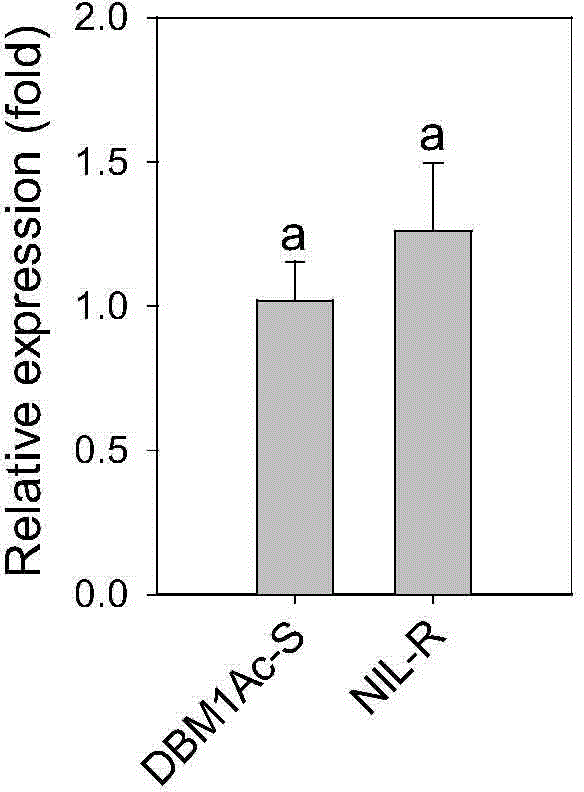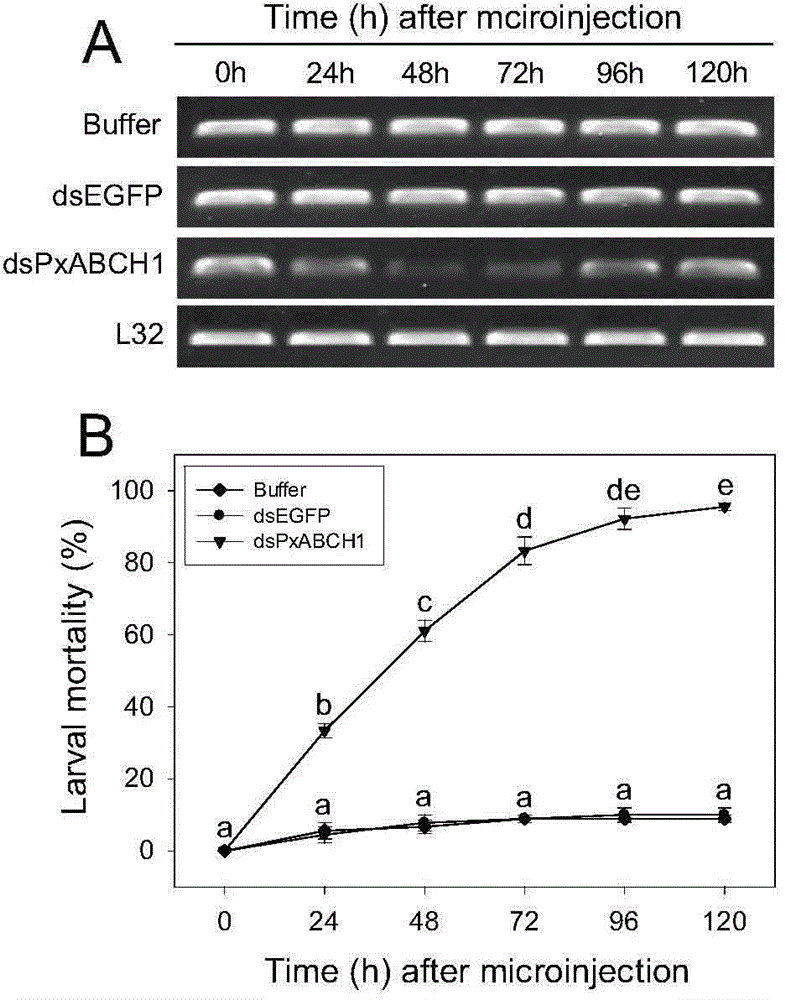ABC transportprotein gene ABCH1 and application of specific dsRNA of ABCH1 in prevention and control of diamond back moth and Bt resistance treatment
A technology of transport protein and diamondback moth, which is applied in the direction of DNA/RNA fragments, applications, genetic engineering, etc., can solve the problems of endangering human health, small promotion area, environmental pollution, etc., and achieve obvious commercial value and application prospects, and obvious technology advantage effect
- Summary
- Abstract
- Description
- Claims
- Application Information
AI Technical Summary
Problems solved by technology
Method used
Image
Examples
Embodiment 1
[0022] Example 1: Cloning of Plutella xylostella ABC transporter gene ABCH1 and comparison of Bt Cry1Ac resistance difference
[0023] 1. Sequence cloning of Plutella xylostella ABCH1 gene
[0024] (1) Search of the sequence of ABCH1 gene of Plutella xylostella in the midgut transcriptome database of Plutella xylostella
[0025] Based on the Plutella xylostella midgut transcriptome database in our laboratory, the sequence of the ABCH1 gene of Plutella xylostella was searched using bioinformatics methods. After sequence analysis and comparison, a sequence fragment of the ABCH1 gene of Plutella xylostella was obtained. The cDNA sequence It is the middle sequence fragment of ABCH1 gene.
[0026] (2) Acquisition of the full-length cDNA sequence of the ABCH1 gene of Plutella xylostella
[0027] Based on the obtained ABCH1 gene fragment of Plutella xylostella, 3′, 5′-RACE primers were designed using Primer Premier 5.0 software. All primers were synthesized by Sangon Bioengineer...
Embodiment 2
[0036] Embodiment 2: dsRNA preparation of Plutella xylostella ABCH1 gene
[0037] (1) Design of dsRNA primers for Plutella xylostella ABCH1 gene
[0038] Based on the cloned full-length sequence of Plutella xylostella ABCH1 gene SEQ ID NO.1, using Primer Premier 5.0 software, the unique transmembrane binding domain TMD ( figure 1 ) designed a specific forward primer SEQ ID NO.4 and a reverse primer SEQ ID NO.5 containing a 23-bp T7 promoter. All primers were synthesized by Sangon Bioengineering (Shanghai) Co., Ltd.
[0039] (2) Synthesis of dsRNA of Plutella xylostella ABCH1 gene and preparation before injection
[0040] Use the above primers SEQ ID NO.4 and SEQ ID NO.5 to amplify a single PCR product by PCR, and use T7 Ribomax after further purification TM The Express RNAi System (Promega, Madison, WI, USA) kit was used to synthesize the specific dsRNA of the Plutella xylostella ABCH1 gene by in vitro reverse transcription according to its instructions, using injection...
Embodiment 3
[0041] Example 3: Plutella xylostella ABCH1 gene dsRNA causes lethal phenotypes in the larval and pupal stages of Plutella xylostella
[0042] 1. Microinjection of Plutella xylostella ABCH1 gene
[0043] The third-instar early Plutella xylostella larvae of the Bt insecticidal protein Cry1Ac-sensitive population DBM1Ac-S and the Plutella xylostella Bt insecticidal protein Cry1Ac-resistant near-isogenic line population NIL-R were starved for 6 hours and frozen for 30 minutes, and then 300 μg ( The prepared dsRNA solution (70 μl) was injected into the body cavity from the abdominal intersegmental membrane of the larvae with a Nanoliter 2000 microinjector, and a total of 90 animals were injected into each treatment group, with 3 biological repetitions (30 animals per repetition). The same volume concentration of Buffer and dsEGFP (mixed with the same volume of Metafectene PRO transfection reagent in the treatment group) was injected into the two control groups, and then the inje...
PUM
 Login to View More
Login to View More Abstract
Description
Claims
Application Information
 Login to View More
Login to View More - R&D
- Intellectual Property
- Life Sciences
- Materials
- Tech Scout
- Unparalleled Data Quality
- Higher Quality Content
- 60% Fewer Hallucinations
Browse by: Latest US Patents, China's latest patents, Technical Efficacy Thesaurus, Application Domain, Technology Topic, Popular Technical Reports.
© 2025 PatSnap. All rights reserved.Legal|Privacy policy|Modern Slavery Act Transparency Statement|Sitemap|About US| Contact US: help@patsnap.com



